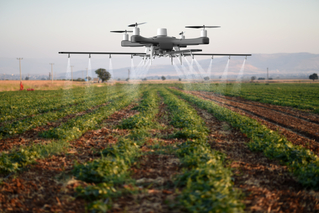 Last week NAAA submitted a letter to EPA Administrator
Andrew Wheeler. The purpose of the letter was to urge the EPA to promptly
evaluate UAS’ ability to make safe and precise and efficacious applications of pesticides,
similarly to how other forms of application—ground, air-blast and single rotor
and single propellered manned aircraft—were evaluated and tested in each
pesticide active ingredient evaluation. UAS, in some instances, are now being used
for making small-scale aerial applications, yet without being tested and
modeled to determine drift potential.
Last week NAAA submitted a letter to EPA Administrator
Andrew Wheeler. The purpose of the letter was to urge the EPA to promptly
evaluate UAS’ ability to make safe and precise and efficacious applications of pesticides,
similarly to how other forms of application—ground, air-blast and single rotor
and single propellered manned aircraft—were evaluated and tested in each
pesticide active ingredient evaluation. UAS, in some instances, are now being used
for making small-scale aerial applications, yet without being tested and
modeled to determine drift potential.
Manned agricultural aircraft, along with ground rigs and
airblast sprayers, have all been evaluated in extensive field studies, many as
part of the Spray Drift Task Force project, and the data collected is used in
the AgDRIFT model. For aerial application, the model allows for a variety of
variables to be examined, including aircraft properties, boom and nozzle
configuration, and wind speed. While EPA typically uses the Tier 1 assumptions
when running AgDRIFT, which uses an AT-401 with specific setup parameters, they
do have the ability to change variables and explore alternatives. As an
example, AgDRIFT was used to verify reducing boom length reduces drift. This
helped secure 15 mph wind speed limits for many pesticides during their
registration review process.
AgDRIFT is used in the pesticide registration and
registration review processes to model the amount of drift from aerial and
other forms of applications. The estimated amounts of drift are then used in the
human health and ecological risk assessments. In turn, these risk assessments
are used to determine if a pesticide will be approved, what application methods
can be used to apply it, and what restrictions need to be placed on the label.
NAAA pointed out that because no UAS are currently modeled in AgDRIFT, it is
currently impossible to evaluate the risk from making an aerial application
with a UAS. Without proper risk assessments, it is impossible to know how safely
and accurately aerial applications with UAS are.
Many consider UAS to be an aerial application and thus already
an approved application platform for any pesticide with an aerial label.
However, NAAA pointed out in the letter to Administrator Wheeler that there are
considerable differences between UAS and manned agricultural aircraft. One
critical difference is weight. Most UAS being marketed for making aerial
applications are much lighter than manned agricultural aircraft. Weight affects
the strength of an aircraft’s wake, which is what pushes the spray down and out
from the aircraft and into the plant canopy. Lighter aircraft do not have as
strong of wakes, which will affect their efficacy and drift potential.
Another key difference between most UAS and manned aircraft
are the number of rotors used. While helicopters utilize a single rotor, UAS
commonly have multiple rotors which is expected to have a significant impact on
vortices generated by the aircraft. In terms of current label restrictions
about boom length relative to wingspan or rotor diameter, there is no data if
these restrictions are appropriate for multi-rotor UAS. NAAA verified the
uncertainty surrounding the accuracy of UAS applications with current research
published in the Transactions of the ASABE (American Society of Agricultural
and Biological Engineers).
NAAA pointed out several other differences, including that
the UAS certification process is not nearly as rigorous and UAS pilots do not
have to have a commercial pilot’s license. PAASS and Operation S.A.F.E. were
described in the letter to demonstrate to the EPA the dedication and
professionalism of the agricultural aviation industry. NAAA also reminded
Administrator Wheeler that Canada’s Pest Management Regulatory Agency (PMRA)
has already determined that the use of UAS to apply pesticides is not permitted
until UAS testing has been completed.
NAAA urged the EPA to begin the field trials for UAS
evaluation so that UAS can be added to AgDRIFT. This is essential for ensuring
that risk assessments accurately reflect the drift potential of UAS, and that
label language can be written specifically for UAS. NAAA will continue to push
for a safe and legal process for UAS to enter the aerial application industry. UAS
may allow for more acres to be treated by air efficaciously and safely but the
data must be generated first so that a proper risk assessment can be developed
for its legal use. A copy of NAAA’s letter
to the EPA can be viewed here.